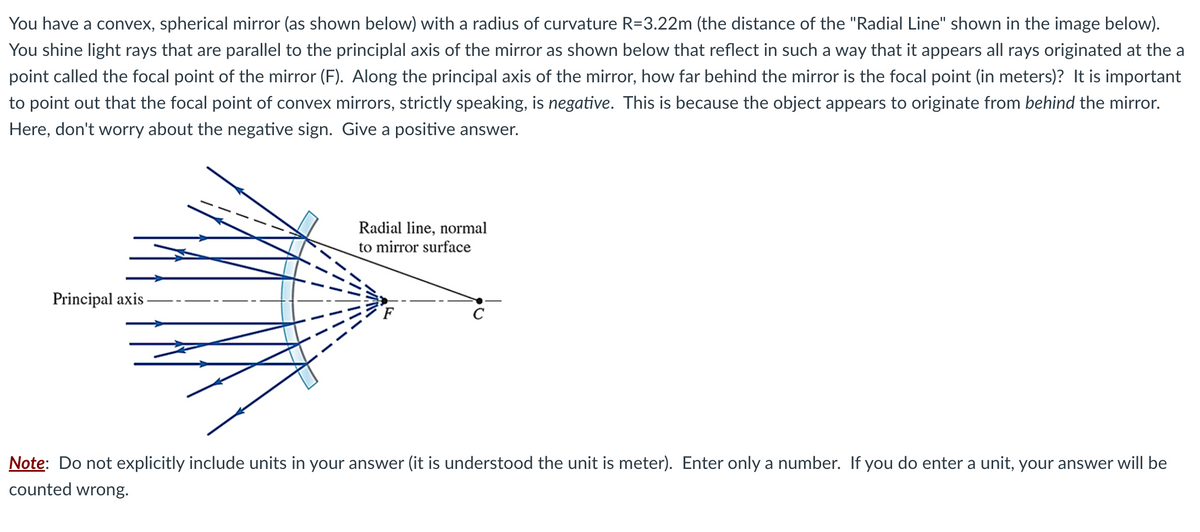You have a convex, spherical mirror (as shown below) with a radius of curvature R=3.22m (the distance of the "Radial Line" shown in the image below). You shine light rays that are parallel to the principlal axis of the mirror as shown below that reflect in such a way that it appears all rays originated at the a point called the focal point of the mirror (F). Along the principal axis of the mirror, how far behind the mirror is the focal point (in meters)? It is important to point out that the focal point of convex mirrors, strictly speaking, is negative. This is because the object appears to originate from behind the mirror. Here, don't worry about the negative sign. Give a positive answer. Principal axis Radial line, normal to mirror surface Note: Do not explicitly include units in your answer (it is understood the unit is meter). Enter only a number. If you do enter a unit, your answer will be counted wrong.
You have a convex, spherical mirror (as shown below) with a radius of curvature R=3.22m (the distance of the "Radial Line" shown in the image below). You shine light rays that are parallel to the principlal axis of the mirror as shown below that reflect in such a way that it appears all rays originated at the a point called the focal point of the mirror (F). Along the principal axis of the mirror, how far behind the mirror is the focal point (in meters)? It is important to point out that the focal point of convex mirrors, strictly speaking, is negative. This is because the object appears to originate from behind the mirror. Here, don't worry about the negative sign. Give a positive answer. Principal axis Radial line, normal to mirror surface Note: Do not explicitly include units in your answer (it is understood the unit is meter). Enter only a number. If you do enter a unit, your answer will be counted wrong.
University Physics Volume 3
17th Edition
ISBN:9781938168185
Author:William Moebs, Jeff Sanny
Publisher:William Moebs, Jeff Sanny
Chapter2: Geometric Optics And Image Formation
Section: Chapter Questions
Problem 13CQ: Use a ruler and a protractor to find the image by refraction in the following cases. Assume an...
Related questions
Concept explainers
Applications Of Reflection Of Light
When a light ray (termed as the incident ray) hits a surface and bounces back (forms a reflected ray), the process of reflection of light has taken place.
Sign Convention for Mirrors
A mirror is made of glass that is coated with a metal amalgam on one side due to which the light ray incident on the surface undergoes reflection and not refraction.
Question

Transcribed Image Text:You have a convex, spherical mirror (as shown below) with a radius of curvature R=3.22m (the distance of the "Radial Line" shown in the image below).
You shine light rays that are parallel to the principlal axis of the mirror as shown below that reflect in such a way that it appears all rays originated at the a
point called the focal point of the mirror (F). Along the principal axis of the mirror, how far behind the mirror is the focal point (in meters)? It is important
to point out that the focal point of convex mirrors, strictly speaking, is negative. This is because the object appears to originate from behind the mirror.
Here, don't worry about the negative sign. Give a positive answer.
Principal axis.
Radial line, normal
to mirror surface
с
Note: Do not explicitly include units in your answer (it is understood the unit is meter). Enter only a number. If you do enter a unit, your answer will be
counted wrong.
Expert Solution
This question has been solved!
Explore an expertly crafted, step-by-step solution for a thorough understanding of key concepts.
Step by step
Solved in 2 steps

Knowledge Booster
Learn more about
Need a deep-dive on the concept behind this application? Look no further. Learn more about this topic, physics and related others by exploring similar questions and additional content below.Recommended textbooks for you

University Physics Volume 3
Physics
ISBN:
9781938168185
Author:
William Moebs, Jeff Sanny
Publisher:
OpenStax

Principles of Physics: A Calculus-Based Text
Physics
ISBN:
9781133104261
Author:
Raymond A. Serway, John W. Jewett
Publisher:
Cengage Learning

Physics for Scientists and Engineers: Foundations…
Physics
ISBN:
9781133939146
Author:
Katz, Debora M.
Publisher:
Cengage Learning

University Physics Volume 3
Physics
ISBN:
9781938168185
Author:
William Moebs, Jeff Sanny
Publisher:
OpenStax

Principles of Physics: A Calculus-Based Text
Physics
ISBN:
9781133104261
Author:
Raymond A. Serway, John W. Jewett
Publisher:
Cengage Learning

Physics for Scientists and Engineers: Foundations…
Physics
ISBN:
9781133939146
Author:
Katz, Debora M.
Publisher:
Cengage Learning